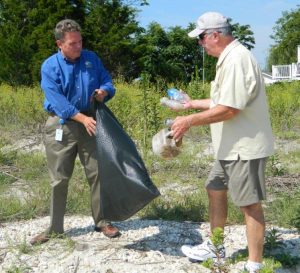
DOVER – DNREC Secretary David Small and Kitts Hummock residents gathered Thursday at the small community on central Delaware’s Bayshore to encourage volunteer signups for the 2016 Delaware Coastal Cleanup, to be held from 9 a.m. to noon on Saturday, Sept. 17 at more than 50 sites statewide.
Sponsored by the Delaware Department of Natural Resources and Environmental Control, the cleanup spans the First State’s 97-mile eastern coastline and includes Delaware River and Bay and Atlantic Ocean shorelines as well as wetland and watershed areas.
“With Delaware’s annual Coastal Cleanup, we know we are making a difference. Not only are we cleaning up trash from our beaches, waterways and watershed areas, we are raising public awareness about trash disposal and recycling,” Secretary Small said. “In addition, the data our volunteers gather helps identify the source of debris and focus efforts on reducing or eliminating it, both locally and internationally.”
Preregistration is open on the Delaware Coastal Cleanup page on the DNREC website, and is strongly encouraged to ensure enough supplies are packed for each site. Preregistration will close Monday, Sept. 5.
“Many of our sites need more volunteers, especially some of our smaller sites along the Delaware Bayshore and in our wildlife areas,” said Delaware Coastal Cleanup Coordinator Joanna Wilson. “The success of the Coastal Cleanup depends on a diverse group of volunteers, from civic organizations, youth groups and businesses to individuals and families, and we want to encourage both new and veteran volunteers to come out and join this important effort Sept. 17. And, it’s a great day outdoors in some of Delaware’s most beautiful and unique places!”
Some of this year’s sites that need additional volunteers are:
New Castle County
- Augustine Beach Wildlife Area – impoundment and boat ramp sites south of Delaware City*
- Cedar Swamp Wildlife Area – Collins Beach Boat Ramp and Thoroughfare Neck Road sites, northeast of Smyrna*
Kent County
- Little Creek Wildlife Area/Port Mahon Road, east of Dover*
- Big Stone Beach and Bennetts Pier, on the Delaware Bayshore near Bowers Beach/Frederica*
Sussex County
- Nanticoke Wildlife Area – Phillips Landing, on the Nanticoke River near Laurel*
- Slaughter Beach near Milford
- Boat Hole/Love Creek, near Lewes*
- Lewes Public Boat Ramp*
- Lewes Beach
- Dewey/Indian Beach
- Bethany Beach
- South Bethany Beach
- Delaware Seashore State Park – 3Rs Road, Keybox Road, North and South Indian River Inlet sites
- Fenwick Island
*Unique smaller sites that especially need volunteers
Popular sites that do not need additional volunteers include Cape Henlopen State Park sites and Rehoboth Beach.
Delaware’s Cleanup is part of the Ocean Conservancy’s International Coastal Cleanup, the world’s largest annual clearing of trash from coastlines and lakes by volunteers. Hundreds of thousands of people all over the world help each year to rid the environment of marine debris and collect detailed information on the types and quantities of refuse they find. This information is recorded on data cards and forwarded to the Center for Marine Conservation, which compiles data for all of the cleanups held in the country and around the world. This information helps identify the source of the debris and focus efforts on eliminating or reducing it.
The Delaware Coastal Cleanup is sponsored by DNREC, which organizes the event, recruits volunteers, distributes supplies, ensures trash removal and tabulates all data collected. Co-sponsors are Edgewell Personal Care/Playtex Manufacturing, which provides gloves, and Waste Management, which hauls trash and recyclables. The Ocean Conservancy supplies trash bags, data cards and brochures on marine debris.
For more information about the Ocean Conservancy and the International Coastal Cleanup, visit www.oceanconservancy.org.
For more information about the Delaware Coastal Cleanup, please call Joanna Wilson, Delaware Coastal Cleanup coordinator, at 302-739-9902.
At the 2015 Delaware Coastal Cleanup, 1,492 dedicated volunteers collected 7.8 tons of trash from 50 sites along Delaware’s shorelines and tributaries. About one-quarter of that trash – mostly aluminum cans and plastic bottles – was recycled. Volunteers’ more unusual finds included a raincoat, a hair dryer, a wig, a perfume bottle, a can of Sterno, a tent, two propane tanks, a bow and arrows, a bike pedal, a dog leash and more than 20 bags of dog waste, a smoke detector, a recliner, a metal bed frame, light bulbs, a paint roller and paintbrush, ceiling tiles, a mop head, trash cans, a sink, a toilet seat, carpet pieces, batteries, a rusty fire pit, a microwave, plastic and wood fencing, a teacup, chopsticks, tiki torch holders and four shot glasses, one of which was still full.
Media Contact: Joanna Wilson, DNREC Public Affairs, 302-739-9902
Vol. 46, No. 316